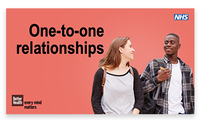One-to-one relationships – KS3 and KS4 lesson plan
Developed with teachers and NHS-approved, this lesson helps students explore the qualities and signs of positive relationships, identify the features of unhealthy, unsafe or abusive relationships and learn how to seek help if they or others are experiencing abusive behaviours. Includes a short video to prompt discussion.
Curriculum
Supports the Relationships and Sex Education statutory guidance
Families
- that there are different types of committed, stable relationships.
Respectful relationships, including friendships
- the characteristics of positive and healthy friendships (in all contexts, including online) including: trust, respect, honesty, kindness, generosity, boundaries, privacy, consent and the management of conflict, reconciliation and ending relationships. This includes different (non-sexual) types of relationship.
- practical steps they can take in a range of different contexts to improve or support respectful relationships.
Intimate and sexual relationships, including sexual health
- how to recognise the characteristics and positive aspects of healthy one-to-one intimate relationships, which include mutual respect, consent, loyalty, trust, shared interests and outlook, sex and friendship.
Supports the PSHE curriculum
KS3
Core theme 2: Relationships
- R1 — about different types of relationships, including those within families, friendships, romantic or intimate relationships and the factors that can affect them
- R10 — the importance of trust in relationships and the behaviours that can undermine or build trust
KS4
Core theme 2: Relationships
- R1 — the characteristics and benefits of strong, positive relationships, including mutual support, trust, respect and equality
- R3 — to respond appropriately to indicators of unhealthy relationships, including seeking help where necessary
Learning outcomes
After this lesson, students will be able to:
- recognise the qualities and signs of a positive relationship
- describe examples of positive relationship behaviours
- identify the features of unhealthy, unsafe or abusive relationships
- explain how someone can seek help if they or others are experiencing abusive behaviours.
Resource details
- Topics: Schools
- Target audience: Students and teachers
- Published: 22 August 2024
- Last updated: 7 August 2024
